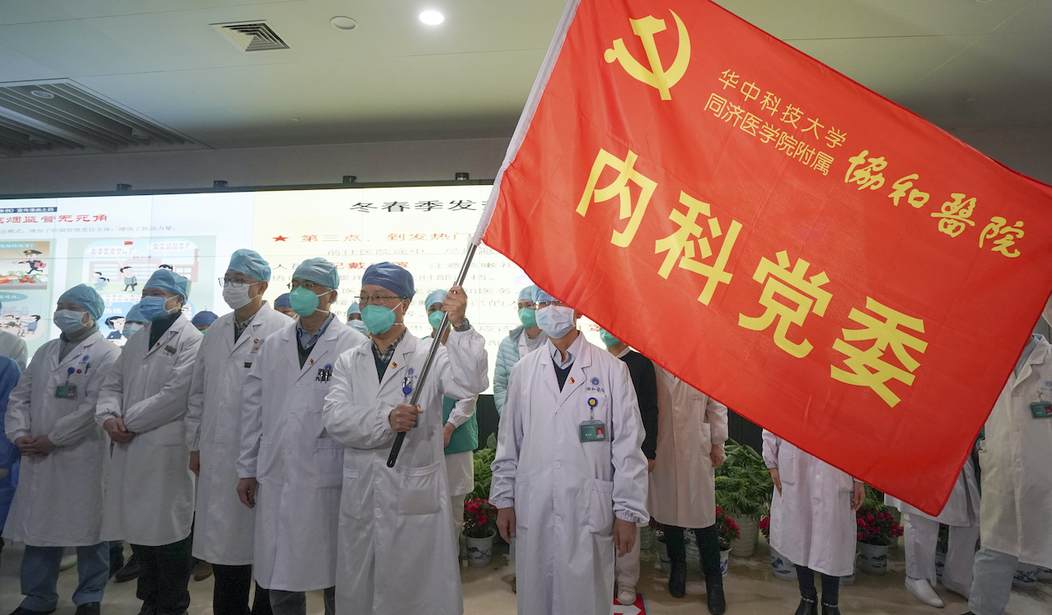It can’t go on forever. Either China will follow Australia’s lead by transitioning from “zero COVID” to “living with COVID” through the magic of vaccination or China will see an outbreak of Omicron erupt so quickly that even a rapid and draconian lockdown can’t contain it. What would that look like?
Think India in the spring of last year. One analysis guesstimates based on western data that Omicron would infect upwards of 93 million people in two months, killing hundreds of thousands in short order. The Chinese health-care system would be brought to its knees. How come?
Two reasons. First, because China has successfully (as far as we know) limited the spread of COVID over the past two years, there’s little natural immunity across the population — “a small fraction of one percent,” perhaps. Second, although the Chinese people are heavily vaccinated, they’ve been using China’s own home-grown vaccines. Those vaccines aren’t very good against Omicron. Even a third dose is unequal to the task.
Which means China is roughly in the same position as Australia was last summer before that country’s vaccination campaign began ramping up, with no defenses against an outbreak except social distancing. Hopefully the Chinese vaccines would provide some protection against severe illness, but there’s every reason to believe Omicron would spread like wildfire if it gained a foothold. And a lot of Chinese with weak immunity from the vaccines would get burned up in the process.
That leaves the leadership with three untenable options. One is to come begging to Pfizer and Moderna for their vaccines. But it’s anyone’s guess how long it would take to fully supply a country as big as China, and even if it could be done, the CCP would be loath to concede that western vaccines are superior. Two is to keep the “zero COVID” policy in place until Chinese scientists have developed their own mRNA vaccines, a process that’s under way. But it’s also anyone’s guess how long it’ll take to perfect and then distribute that product. And in the meantime, China remains at daily risk of an Omicron tidal wave.
The third option is to practice “zero COVID” forever. China prides itself on its ability to contain the virus, touting its low official death count as proof that dictatorship and omnipresent surveillance prove the superiority of Chinese totalitarianism to western liberalism. But it’s simply not sustainable long-term, wrote Ezekiel Emanuel and Michael “Dr. Doom” Osterholm a few days ago. The virus will win eventually. China is risking catastrophe if it doesn’t accept that and start transitioning to living with COVID.
You know the situation is dire when Dr. Doom is urging people to take fewer precautions.
For those who become infected, China has limited outpatient medical facilities or home care. Many of those who fall ill will not be able to call a primary care physician, go to an urgent care center or get care at home. And if millions need care — even if they don’t need to be hospitalized — the hospitals will rapidly be overwhelmed. Hospitals might even become sites of superspreading events. As recent episodes in the city of Xi’an showed, Chinese hospitals fearful of the virus may deny care to those in need…
[A] zero-Covid policy means the Chinese will always be chasing an ever moving target. And they will never win. Inevitably this will have serious economic impacts for China — and for all of us, given the country’s position in the world economy. While China remains the production capital of the world, this is unlikely to be sustainable should lockdowns ensue. Businesses outside of China are likely to become increasingly hesitant to partner with Chinese ventures when they are unable to enter the country to meet partners and inspect factories that face unpredictable closings. Declines in Chinese production would upend supply chains and the availability of goods everywhere, including in the United States.
One model of an Omicron outbreak in China found that the country could still experience “huge” amounts of illness and death even if it’s assumed that 80-90 percent of the population has been vaccinated with the extant Chinese vaccines. In fact, the modeler recommended trying to maintain “zero COVID” until 90 percent of the population has had a third dose, in hopes that that might limit the numbers killed once restrictions are lifted. The fact that Beijing persists with the “zero COVID” approach to this day, even after countries like Australia have transitioned out of it, is a glaring admission that the regime doesn’t trust its own vaccines. Australia at least had Pfizer and AstraZeneca to rely on. China has … SinoPharm and SinoVac.
“Zero COVID” has saved lives but it’s cost China in other ways, and those costs will become unbearable as time wears on if it doesn’t change course:
The government has not made clear the economic costs of its policies, but local examples provide some indication of the staggering amounts in question: in order to stamp out a single outbreak of less than a few hundred cases in Guangzhou during May and June 2021, for example, the local government reportedly spent approximately $1 billion on testing for 32 million people. And because lockdowns have frequently involved entire municipalities, local businesses in disparate parts of the country have been forced to close abruptly for long stretches, keeping many people off-balance. In Zhengzhou, the capital of central Henan Province, more than 40 percent of local shops with street frontage closed down during a 26-day outbreak last August. According to Tianyancha, a business data and investigation platform, in the first 11 months of 2021, 4.37 million small businesses in China closed while only 1.32 million new ones registered, compared with 6.13 million new small businesses opening in 2020.
If they’re very lucky, they’ll figure out a way to get everyone boosted with quality vaccines and then “only” have to endure the sort of short-term disruptive misery that we’ve spent the past six weeks suffering through. And even that best-case scenario would probably involve 10,000 people or more per day dying during the worst of it, if America’s numbers are any yardstick.
Meanwhile, although China has managed to keep the capital largely COVID-free since 2020, Omicron has begun to creep in. Movement in parts of Beijing has been limited ahead of the Olympics to prevent transmission, with millions told to line up in freezing temperatures for mass testing. A city of a million people located 60 miles from Beijing has reportedly been quietly locked down for seven days, with businesses shuttered. “Zero COVID” has painted them into a corner. How do they get out?







Join the conversation as a VIP Member